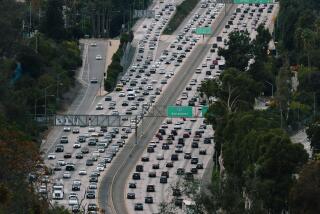Rodriguez: L.A.’s way is the freeway
Los Angeles County Supervisor Zev Yaroslavsky’s office released a mildly amusing list of 53 suggestions for surviving “Carmageddon,” one for every hour the 405 will be closed this weekend between the 10 and the 101. In the hope that you’ll stay off the streets — please! for God’s sake! — the list suggests planting a tree, shopping online (from county-based stores, of course), throwing a block party. What it doesn’t do is encourage Angelenos to appreciate our freeway system and to imagine for a moment what the city would be like without what historian Kevin Starr has called “absolute masterpieces of engineering.”
For starters, by my calculations, it would take three times as long to drive from, say, Culver City to Redlands, or Glendale to Anaheim, although even Los Angeles County’s 527 miles of limited-access roadway can’t compensate for all the new cars we crowd onto the freeways and the SigAlerts we cause.
The truth is, we take our freeways for granted, and we take every opportunity to badmouth them. They get blamed for destroying neighborhoods, uglifying the landscape and atomizing us, alone in our cars, as we hurtle toward alienation. But that’s too easy. Traffic jams and idiot drivers notwithstanding, the freeways connect us at least as much as they separate us.
Onetime Angeleno Joan Didion called the freeways “the only secular communion Los Angeles has.” Indeed, they are the one place we all gather with a single purpose. They are the arena, as architectural critic and L.A. evangelist Reyner Banham put it, where we act out the “paradoxes in the great debate between private freedom and public discipline.”
There are dozens of examples of the way they knit us together: Route comparisons around the water cooler (“No, no, take the 2 to the 210 to the 118; forget the 5!”), the folk wisdom contained in knowing how to time a trip to LAX, the “did you see that” bonhomie of a good freeway chase. The grandest freeway chase of them all, when the white Bronco carried O.J. hither and yon, not only brought us together around TV sets, it made the 405 overpasses into front-row seats on history. And those seats were packed.
I’ll admit there are all sorts of reasons why public transportation is morally superior to cars and freeways. It’s easier on the environment; it’s constantly, genuinely, physically communal; it forces us to walk and to see, hear and touch more of Los Angeles more directly. But for now at least, the bus system and our barely there subway and light-rail lines can’t compete when it comes to another aspect of the common good: freedom.
We can drive the freeways on our own schedules, precisely to where we need to go. By helping the city spread far and wide, freeways give us greater choice in where we can live. And then there’s that primal feeling of liberation you get when you roll down the window, pump up the radio volume and feel the wind in your hair.
Admit it: You prefer the communion of the freeways to the communion of public transportation. New Yorker David Rieff, in his 1991 book, “Los Angeles: Capital of the Third World,” called freeways the epitome of Western individualism. “Cowboys don’t ride buses,” he snarled. Like it or not, freeways are essential to the fluid, decentralized and anti-conformist culture we Angelenos like to boast about.
I walk to work daily. My apartment is a mere block from my office. That makes me a SoCal turncoat, but I make up for it every Friday evening when I drive two hours to the desert. Not that it’s easy. I’m addicted to the traffic-map app on my iPhone, and I approach each trip into and out of town as if it were a small-scale moon landing. I have a Plan B, and a Plan C. And yeah, I’ve even given up and turned back once or twice.
Ten measly miles of roadway will be closed this weekend. Yet the mayor suggests you leave town. The Getty Center is closing its doors. “Expect big delays” signs have been flashing as far away as Tustin. Face it: If it’s Carmageddon or a repeat of the no-jam miracle of the 1984 Olympics, the message is the same: You can romanticize bicycles, subways or light rail all you want, but freeways are what make us who we are.


